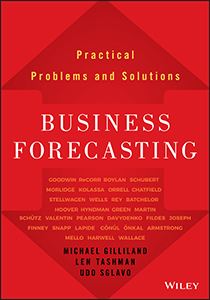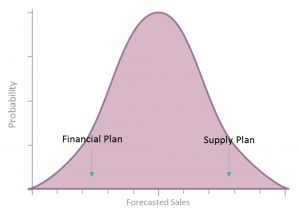Back in 2013 the BFD asked Is one number forecasting a new worst practice?, concluding yes.
Certainly, it is important for an organization to be aligned, with different functions like sales, supply chain, and finance not going off independently in their own directions, doing whatever they want. But trying to force everyone to plan to a one-number point forecast is unrealistic and counter-productive.
The issue is that there are asymmetric costs to forecast error for the different functions. Consider a simple example of asymmetric costs, adapted from the new book Forecasting: An Essential Introduction by Castle, Clements, and Hendry. (Find my review of the book in the upcoming Fall 2019 issue of Foresight.)
You need to arrive at the airport by 7:00 for your flight, and in many such prior trips, the drive has taken an average of 30 minutes with a standard deviation of 3 minutes. There is no real cost to arriving early, but a huge cost in inconvenience (and perhaps re-booking fees) if you arrive even one minute late and miss your flight. So you plan to depart at 6:20 and expect (by your 30 minute point forecast) to arrive 10 minutes early, with very little chance of arriving late.
Different functions in an organization have their own unique, asymmetric costs to errors:
- A CFO may wish to be conservative in planning revenue. Everyone is happy when revenue exceeds the plan, but there can be severe costs if revenue falls short (for example, insufficient cash to pay suppliers or meet payroll).
- A COO running supply chain may want to have plenty of inventory on hand, to be able to service unexpectedly high demand. (This is especially true when inventory is cheap to hold, and unfilled orders lead customers to competitors.)
In his article "Communicating the Forecast: Providing Decision Makers with insights" in the Summer 2019 issue of Foresight, Alec Finney provides a nice visual for this situation (adapted slightly for this blog post):
The first thing to note is that Finney starts with a density forecast -- more effort to create, but much for valuable for decision making than just a point forecast.* He shows where a financial planner and a supply planner utilize different points in the forecast distribution to appropriately manage their risks. As Finney asserts:
Does this communicate the forecast in an effective way? I believe it does. The alternative is to create a "Consensus Forecast" -- more appropriately, a "Compromise Forecast" -- where none of the functional planning requirements are met. Better to afford each function the choice of how to manage expectations and risk; at the least, their plans will be made transparent and can be monitored and amended when necessary.
-----------------
 *See Paul Goodwin, "Getting Real About Uncertainty" in the Spring 2014 issue of Foresight for an excellent discussion of ways to depict uncertainty in forecasts. Become a member of the International Institute of Forecasters to receive a subscription to Foresight along with free online access to all 50+ previous issues. Goodwin's article also appears in the book Business Forecasting: Practical Problems and Solutions.
*See Paul Goodwin, "Getting Real About Uncertainty" in the Spring 2014 issue of Foresight for an excellent discussion of ways to depict uncertainty in forecasts. Become a member of the International Institute of Forecasters to receive a subscription to Foresight along with free online access to all 50+ previous issues. Goodwin's article also appears in the book Business Forecasting: Practical Problems and Solutions.


1 Comment
Hi Mike, I really enjoyed reading your blog, and the concept of asymmetric costs to forecast error. I definitely see your point on needing multiple forecasts, as I see some large companies standardized on ERP for their mainstream planning processes, but augment that with SAS Forecasting for some of their critical processes.